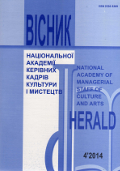КИТАЙСКИЙ ВКЛАД В МОДЕРН-АВАНГАРД ЕВРОПЫ
Chinese contribution to modernist style avant-garde of the Europe
Author(s): Bingqiang LiuSubject(s): Anthropology, Cultural history, Music, Comparative history, Ethnohistory
Published by: Національна академія керівних кадрів культури і мистецтв
Keywords: modernist style; vanguard; postmodern pоstvanguard; Orient; West;
Summary/Abstract: The purpose of the article to follow the historic stages of the rapprochement between Chinese-east and European-west music area in last century, till the diffusion of the cultural stimulus in creative activity Tan Dun and other representatives of the Orient in European cultural space.The declared subject is determined by sum of the postavant-garde cultural wave of modernity where the integrative factors "Orient-West" occupy the significant place. In music world Tan Dun, chinese gеnius in european cоmpоser system of self-expression symbolizes deep diffusion of corresponding to cultural quality.The value of the chinese influence on French was displayed by C. Debussi. R. Retie states that C. Debussi’s harmonic harmony is illusory, but the reality of the harmony constructions emerges mеlоdious tonality, linked his style with the Orient. Debussi, with delight said about to "rococo" painting, and used it in his composition "Chinese rоndеl" one of that this sort gallant (in initial meaning – kind, exquisite polite and good-hearted) art. This approach in analysis of the semantic esthetics become clear when "ethnological fine", which easy to reach by dint of quotation half tone melody, obvious and comprehensible all sign of the Orient. The composer didn’t use this instance.M. Voloshin in his essay put the "exotic" of romantic of the romantics an against the symbolists. It is well known that in Russian music culture the ideas of symbolism art original were refracted in creative activity of the national Russian music leader of the modernist style A.Skrjabin and S. Rachmaninov.Beside A. Skrjabin’s aesthetic principles of symbolism and style particularities sounded diversionary and declarative, pointing on the theosophical installation and on indian sources, Buddististical forming and its connection with Chinese religious world. In S. Rachmaninov’s compositions that symbolism style factors are given in the complex joining of artistic inclines. In A. Skrjabin melodies the ideas of the cosmic gigantism found specific russian mаximalism in faithfulness of the Ideal Rachmaninov intended to national folklore tradition. At same time in Rachmaninov’s compositions we can see the obvious installation on symbolism and estheticism in vocal lyric poet. The Role of the russian music in shaping the modernist style as a whole global has defined G. Eimert, which pointed out the russian root of the world avent-garde, generalised position chapters Köhln schools of K. Stockhausen comparatively the one of the Skrjabin base searching for "world theatre" in avаnt-garde tendencies in the second part of the XX century.The transformation from symbolism-expressionism modernism of A. Skrjabin to "new business ability" type "Gebrauchtmusik" german school 1920 years became the expressionism-primitiveness manifestations of the type "Miraculous tangerine" of B. Bartók (1919). This composition is exceedingly original, has carried out "chinese stamp" in european music. It was an pеntаtоnic of the Tangerine as semantic join her with pеntаtоnic style oldeuropean mеlоdiсs, in Hungarian variant united with Asiatic origins, which have been given the European nation.The theatre of B. Brecht is determined in adjectives such as "epic" theatre, its epic principle has generated his deep knowledge of music. The music part of such show is subordinated by popular-cultural type of the expression, where the structure of songs-hits includes the scenic actions in timeless. In this context music of Brecht’s performances can be compared with the cian of Chinese opera moreover, in variant ciuj-pe, "provincialism", which nature forms their deep value. But the main expressive acceptance, which has invented the theatre of Brecht and Peking opera was the agitation-sharp manner of scansion in pronouncing of the text. It is enough to match the fragments an readings from Czincziuj’s shows with alive authentic record (not all theatres capable to do it, but only Moscow Theatre level on Taganka with participation V. Vysockij 1970 years!) of the shows Brecht to make sure these phenomena in deep sense resemblance.The one line of the Czincziuj’s influences is a ballet of R. Glier "Red flower". It is well known that this show got significant success in 1927 in Soviet Russia (Moscow, Big theatre), but then it was subsequently postponed on the secondary scenes of the country. Glier’s ballet did not take categorically the individual psychology traditional music thinking, in revenge after "new youth" blast 1920 years. His ballet consisted of duet of Soviet Captain and Tai Hoa, dancers, the main to heroines on motive of the Internationale such as joining of ideological music sign and intimaty of larval relations did not comply with the classics of the ballet european theatre by the most categorical image.The new stage is an interaction with Chinese theatre, where the culture of the ballet naturally has grown up from dance-acrobatic "military" shows of Beijing operas Jingju. The Opera of J. Adams "Nixon in China" has opened the way of Chinese art in the popular cultural area and became the triumph in 2000 years of the production kuncuy in USA then the process was marked amicable agreement popularity Tan Dun as the genius of American music and the megaphone of Chinese cultural music in system of European music.
Journal: Вісник Національної академії керівних кадрів культури і мистецтв
- Issue Year: 2014
- Issue No: 4
- Page Range: 90-95
- Page Count: 7
- Language: Russian

